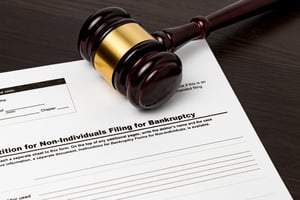 A chapter 13 bankruptcy case is a three to five year repayment plan wherein the debtor makes monthly payments towards their debts. After successfully completing their repayment plan, the debtor’s remaining unsecured debts are discharged, with some exceptions (i.e. student loans). Once the bankruptcy court “confirms,” or officially approves, the debtor’s repayment plan (typically a few months after their case is filed), the debtor is bound to contribute all of their disposable income towards their monthly payments.
A chapter 13 bankruptcy case is a three to five year repayment plan wherein the debtor makes monthly payments towards their debts. After successfully completing their repayment plan, the debtor’s remaining unsecured debts are discharged, with some exceptions (i.e. student loans). Once the bankruptcy court “confirms,” or officially approves, the debtor’s repayment plan (typically a few months after their case is filed), the debtor is bound to contribute all of their disposable income towards their monthly payments.
The debtor’s disposable income is the amount of money they have left over, each month, after paying all of their normal monthly expenses. Once court confirms the repayment plan, the debtor is committed to contributing all of their disposable income for the amount of time they pledged in their repayment plan, which is no less than three years and no more than five years. Due to the fact that chapter 13 cases last for multiple years, and life circumstances can easily change, it is not surprising that people often have difficulty continuing to make their monthly payments for this entire time period. There are options for those debtors who find themselves unable to continue making their bankruptcy payments.
Voluntarily Dismissing the Chapter 13 Case
The great thing about a chapter 13 repayment plan is that it is essentially completely voluntary. This means that the debtor has virtually an absolute right to ask the court to dismiss their case, at any time, and for any reason, so long as they are not acting in bad faith (i.e. intentionally abusing the process to defraud creditors). This is different from a chapter 7, in which the debtor must request court permission to dismiss their case, which is often denied by the court. Although it may be comforting for a debtor to know that they can basically dismiss their chapter 13 whenever they want, this option should typically be avoided, and the debtor is usually better served by continuing to remaining in, and completing, a bankruptcy case, if at all possible. The consequence of voluntarily dismissing one’s chapter 13 bankruptcy case is that the debtor loses the protection of the court, particularly the automatic stay, which allows creditors to pursue their collection actions against the debtor just as they could before the bankruptcy case is filed. The debtor loses one of the primary benefits of their bankruptcy case, the discharge, which means they are legally responsible for paying the entire amount of their debt back, often with interest. To the extent the debtor is behind on car or home payments when they dismiss their case, the creditor can exercise their right to repossession or foreclosure. However, the good news is that the debtor can regain the protection of the bankruptcy court by simply filing another chapter 13 case. The debtor can file another case whenever they want, with exception that they must wait, at least, 180 days from the date the court dismisses their previous chapter 13 case, if the debtor dismissed their case in response to a creditor filing a motion asking the court to lift the bankruptcy automatic stay (asking the court for permission to repossess a car or foreclose on a home). The debtor must also wait 180 days to refile if their case was dismissed due to the debtor’s failure to abide by an order of the bankruptcy court.
Modifying the Chapter 13 Plan
A better option to dismissal is often for the debtor to file a modified repayment plan with the court. Often times, unforeseen changes in financial circumstances, such as job loss or increased expenses, can make it difficult or impossible for the debtor to continue making their plan payments. When this happens, the debtor can file a motion requesting the court confirm a new repayment plan filed by the debtor. The modified plan may provide that the debtor’s payments be permanently reduced if their change in income/expenses is of a long-term nature, so long as their plan still pays creditors as much as was required to be confirmed in the first place. If the changes in financial circumstances are more temporary in nature, the modified plan may provide for temporarily reduced payments, sometimes with a provision of increased or lump-sum payments to allow the debtor to get caught up on payments when their financial situation improves down the road. Again, any proposed modified repayment plan must be confirmed by the court and provide sufficient payment to creditors, as required by the Bankruptcy Code.
Conversion to Chapter 7
A debtor has the right to convert their bankruptcy from a chapter 13 case into a chapter 7 case whenever they want so long as they aren’t doing so with the bad faith intention of defrauding their creditors. An example of a bad faith conversion would be a debtor who initially made too much money to be in a chapter 7 case, intentionally quitting their high-paying job to work at a lower-paying job just so they could convert to a chapter 7 case. Converting to a chapter 7 is often a good option if the debtor experiences a change in financial circumstances beyond their control and can no longer afford making monthly payments. The debtor does not have to make payments in a chapter 7 case, and typically, receives a discharge a few months after converting their case. If the debtor incurred debt after filing their chapter 13 case, but before filing their chapter 7 case, they can even include these debts in their chapter 7 case, which will get discharged in that case. However, converting to a chapter 7 is not always a perfect solution. For example, if the debtor has a substantial amount of “nonexempt property,” meaning property that is not legally protected from being taken to pay their creditors, the chapter 7 bankruptcy attorney may take the nonexempt property to use to pay towards their debts. Trustees cannot take property in a chapter 13, however the catch is that the minimum amount that the debtor must pay to their unsecured creditors during the course of their chapter 13 repayment plan is, at least, the amount of money the creditors would have received had the debtor filed a chapter 7 case. Another potential drawback to converting a case from a chapter 13 to a chapter 7 is that certain debts that were to be fully paid in a chapter 13, such as priority tax debts and past-due domestic support obligations (i.e. child support and alimony), will remain unpaid after the chapter 7 discharge, and must be paid directly to the creditor outside of bankruptcy. Lastly, another problem with converting to a chapter 7 is that, if the debtor is still delinquent in car or house payments when they convert their case, they risk having their car repossessed or home foreclosed upon after their chapter 7 case is completed (or sooner if the creditor files a motion asking the court for relief from the automatic stay).
Requesting a Hardship Discharge
Another option that debtors have when facing difficulty or inability in continuing to make their chapter 13 payments, is to file a motion asking the court to grant a “hardship discharge.” In order for the court to grant a hardship discharge the debtor must prove that the reason they cannot continue making plan payments is due to circumstances beyond their control that inhibit them from continuing to make payments to creditors. Typically, the debtor must show that their changed financial circumstances are more permanent, rather than temporary, in nature and are sufficiently extreme for them to be justified in not being able to make payments. The debtor must also prove to the court that modifying their plan to accommodate their changed financial circumstances is not practical. This essentially means that is virtually impossible for the debtor to modify their plan in a manner that would enable them to successfully complete their repayment plan. Lastly, the debtor must have already paid, at least, as much to their unsecured creditors from their chapter 13 payments as the creditors would have received had they filed a chapter 7 case. This is determined by calculating how much the unsecured creditors would have received from the trustee “liquidating,” or taking the debtor’ nonexempt property to pay the creditors in a hypothetical chapter 7 case. If the debtor can prove all of these things, the court will grant the discharge to the debtor. The potential drawbacks to the court granting the hardship discharge, just as with converting a case to a chapter 7, is that certain priority debts, such as tax debt and domestic support obligations, will remain unpaid as well as past-due home or car payments, leaving the debtor responsible for making these payments outside of their bankruptcy case. The benefit of the hardship discharge being granted is that the debtor does not lose any nonexempt property that they would have had taken had they converted to a chapter 7 case.
CALL NOW FOR A FREE STRATEGY SESSION FROM A MN BANKRUPTCY LAWYER AT LIFEBACK LAW FIRM
Debtors frequently have difficulty making all of their bankruptcy payments due to the length of time that they are required to be in a chapter 13 repayment plan. However, there are options for debtors who encounter financial circumstances which inhibit their ability to continue making payments, such as modifying their repayment plan, converting their case to a chapter 7, requesting that the court grant a hardship discharge, or even outright dismissing their case altogether. It is wise for a person considering filing for bankruptcy to first consult with an experienced bankruptcy attorney to ensure they are best protected from the beginning of their case until the end. See us at LifeBackLaw.com!


